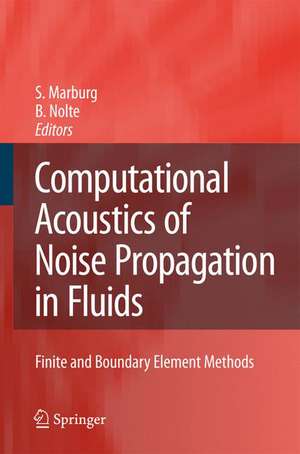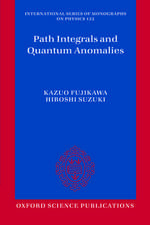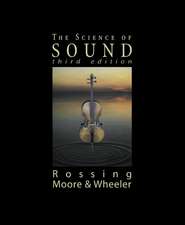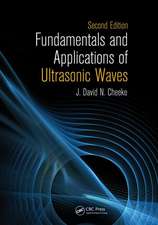Computational Acoustics of Noise Propagation in Fluids - Finite and Boundary Element Methods
Editat de Steffen Marburg, Bodo Nolteen Limba Engleză Hardback – 2 mar 2008
| Toate formatele și edițiile | Preț | Express |
|---|---|---|
| Paperback (1) | 958.56 lei 6-8 săpt. | |
| Springer Berlin, Heidelberg – 9 noi 2010 | 958.56 lei 6-8 săpt. | |
| Hardback (1) | 962.35 lei 6-8 săpt. | |
| Springer Berlin, Heidelberg – 2 mar 2008 | 962.35 lei 6-8 săpt. |
Preț: 962.35 lei
Preț vechi: 1173.60 lei
-18% Nou
Puncte Express: 1444
Preț estimativ în valută:
184.20€ • 200.15$ • 154.83£
184.20€ • 200.15$ • 154.83£
Carte tipărită la comandă
Livrare economică 21 aprilie-05 mai
Preluare comenzi: 021 569.72.76
Specificații
ISBN-13: 9783540774471
ISBN-10: 3540774475
Pagini: 596
Ilustrații: XIII, 578 p.
Dimensiuni: 155 x 235 x 37 mm
Greutate: 0.93 kg
Ediția:2008
Editura: Springer Berlin, Heidelberg
Colecția Springer
Locul publicării:Berlin, Heidelberg, Germany
ISBN-10: 3540774475
Pagini: 596
Ilustrații: XIII, 578 p.
Dimensiuni: 155 x 235 x 37 mm
Greutate: 0.93 kg
Ediția:2008
Editura: Springer Berlin, Heidelberg
Colecția Springer
Locul publicării:Berlin, Heidelberg, Germany
Public țintă
ResearchDescriere
Among numerical methods applied in acoustics, the Finite Element Method (FEM) is normally favored for interior problems whereas the Boundary Element Method (BEM) is quite popular for exterior ones.
That is why this valuable reference provides a complete survey of methods for computational acoustics, namely FEM and BEM. It demonstrates that both methods can be effectively used in the complementary cases.
The chapters by well-known authors are evenly balanced: 10 chapters on FEM and 10 on BEM. An initial conceptual chapter describes the derivation of the wave equation and supplies a unified approach to FEM and BEM for the harmonic case. A categorization of the remaining chapters and a personal outlook complete this introduction. In what follows, both FEM and BEM are discussed in the context of very different problems.
Firstly, this comprises numerical issues, e.g. convergence, multi-frequency solutions and highly efficient methods; and secondly, solutions techniques for the particular difficulties that arise with external problems, e.g. discussion of absorbing boundaries for FEM and treatment of the non-uniqueness problem for BEM. Finally, both parts on FEM and on BEM are completed by chapters on related problems, e.g. formulations for fluid-structure interaction. In addition to time-harmonic problems, transient problems are considered in some chapters. Many theoretical and industrial applications are presented.
Overall, this book is a unified review of the state-of-the-art on FEM and BEM for computational acoustics.
That is why this valuable reference provides a complete survey of methods for computational acoustics, namely FEM and BEM. It demonstrates that both methods can be effectively used in the complementary cases.
The chapters by well-known authors are evenly balanced: 10 chapters on FEM and 10 on BEM. An initial conceptual chapter describes the derivation of the wave equation and supplies a unified approach to FEM and BEM for the harmonic case. A categorization of the remaining chapters and a personal outlook complete this introduction. In what follows, both FEM and BEM are discussed in the context of very different problems.
Firstly, this comprises numerical issues, e.g. convergence, multi-frequency solutions and highly efficient methods; and secondly, solutions techniques for the particular difficulties that arise with external problems, e.g. discussion of absorbing boundaries for FEM and treatment of the non-uniqueness problem for BEM. Finally, both parts on FEM and on BEM are completed by chapters on related problems, e.g. formulations for fluid-structure interaction. In addition to time-harmonic problems, transient problems are considered in some chapters. Many theoretical and industrial applications are presented.
Overall, this book is a unified review of the state-of-the-art on FEM and BEM for computational acoustics.
Cuprins
Part I FEM: Numerical Aspects 1 Dispersion, Pollution, and Resolution.2 Different Types of Finite Elements.3 Multifrequency Analysis using Matrix Pad´e–via–Lanczos.4 Computational Aeroacoustics based on Lighthill’s Acoustic Analogy.Part II FEM: External Problems5 Computational Absorbing Boundaries.6 PerfectlyMatched Layers.7 Infinite Elements.8 Efficient Infinite Elements based on Jacobi Polynomials.Part III FEM: Related Problems9 Fluid–Structure Acoustic Interaction.10 Energy Finite Element Method.Part IV BEM: Numerical Aspects11 Discretization Requirements.12 Fast Solution Methods.13 Multi–domain Boundary Element Method in Acoustics.14 Waveguide Boundary Spectral Finite Elements.Part V BEM: External Problems15 Treating the Phenomenon of Irregular Frequencies.16 A Galerkin-type BE-formulation.17 Acoustical Radiation and Scattering above an Impedance Plane.18 Time Domain BEM.Part VI BEM: Related Problems19 Coupling a Fast BEM with a FE-Formulation for Fluid–Structure Interaction.20 Inverse BE-Techniques for the Holographic Identification of Vibro–Acoustic Source Parameters
Recenzii
From the reviews:“This book contains a review of recent developments and new results for the application of finite and boundary element methods in acoustic simulations. … Without a doubt it will become a popular reference in the acoustic community. The volume can be highly recommended to graduate students and young researchers, as well as practitioners in the industry, as a representative compilation of recent methodical developments and interesting applications in the broad field of vibroacoustic simulation.” (Frank Ihlenburg, Acta Acustica United With Acustica, Vol. 95 (4), 2009)
Textul de pe ultima copertă
Among numerical methods applied in acoustics, the Finite Element Method (FEM) is normally favored for interior problems whereas the Boundary Element Method (BEM) is quite popular for exterior ones.
That is why this valuable reference provides a complete survey of methods for computational acoustics, namely FEM and BEM. It demonstrates that both methods can be effectively used in the complementary cases.
The chapters by well-known authors are evenly balanced: 10 chapters on FEM and 10 on BEM. An initial conceptual chapter describes the derivation of the wave equation and supplies a unified approach to FEM and BEM for the harmonic case. A categorization of the remaining chapters and a personal outlook complete this introduction. In what follows, both FEM and BEM are discussed in the context of very different problems.
Firstly, this comprises numerical issues, e.g. convergence, multi-frequency solutions and highly efficient methods; and secondly, solutions techniques for the particular difficulties that arise with external problems, e.g. discussion of absorbing boundaries for FEM and treatment of the non-uniqueness problem for BEM. Finally, both parts on FEM and on BEM are completed by chapters on related problems, e.g. formulations for fluid-structure interaction. In addition to time-harmonic problems, transient problems are considered in some chapters. Many theoretical and industrial applications are presented.
Overall, this book is a unified review of the state-of-the-art on FEM and BEM for computational acoustics.
That is why this valuable reference provides a complete survey of methods for computational acoustics, namely FEM and BEM. It demonstrates that both methods can be effectively used in the complementary cases.
The chapters by well-known authors are evenly balanced: 10 chapters on FEM and 10 on BEM. An initial conceptual chapter describes the derivation of the wave equation and supplies a unified approach to FEM and BEM for the harmonic case. A categorization of the remaining chapters and a personal outlook complete this introduction. In what follows, both FEM and BEM are discussed in the context of very different problems.
Firstly, this comprises numerical issues, e.g. convergence, multi-frequency solutions and highly efficient methods; and secondly, solutions techniques for the particular difficulties that arise with external problems, e.g. discussion of absorbing boundaries for FEM and treatment of the non-uniqueness problem for BEM. Finally, both parts on FEM and on BEM are completed by chapters on related problems, e.g. formulations for fluid-structure interaction. In addition to time-harmonic problems, transient problems are considered in some chapters. Many theoretical and industrial applications are presented.
Overall, this book is a unified review of the state-of-the-art on FEM and BEM for computational acoustics.
Caracteristici
Only book summarizing FEM and BEM (and optimization) for acoustics
The chapters discuss fundamental issues of the methods
Methods will be presented for engineers, even if they are described by mathematicians
Includes supplementary material: sn.pub/extras
The chapters discuss fundamental issues of the methods
Methods will be presented for engineers, even if they are described by mathematicians
Includes supplementary material: sn.pub/extras















